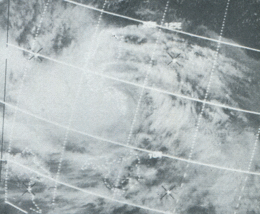Typhoon Joan (1970)
| Category 5 (Saffir–Simpson scale) | |

Super Typhoon Joan was the largest typhoon in size during the 1970 season. This image shows the size of the storm.
|
|
| Formed | October 10, 1970 |
|---|---|
| Dissipated | October 18, 1970 |
| Highest winds |
1-minute sustained: 280 km/h (175 mph) |
| Lowest pressure | 905 hPa (mbar); 26.72 inHg |
| Fatalities | 768 direct (includes 193 unaccounted for) |
| Damage | $74 million (1970 USD) |
| Areas affected | Ulithi Atoll of the Caroline Islands, Philippines, Hainan Island and Southeastern People's Republic of China Hong Kong |
| Part of the 1970 Pacific typhoon season | |
Super Typhoon Joan, known in the Philippines as Typhoon Sening, was the first of two super typhoons to strike the Philippines within a week in October 1970, the second being Super Typhoon Kate. Super Typhoon Joan is the second strongest typhoon and the tenth deadliest storm, ever to affect the Philippines, just after Typhoon Haiyan in 2013.
A tropical disturbance was first detected on October 8 near Truk (now Chuuk) and Ponape (now Pohnpei). Due to the wind and sea conditions, the disturbance moved west quicker than expected at near 17 knots (31 km/h or 20 mph). A circulation developed on the morning of October 9, and it was a tropical storm by the time it passed Ulithi Atoll.
Joan continued to strengthen, and by October 11 had become a typhoon. However, it had slowed in forward speed due to it moving near an anticyclone that was located 300 miles (480 km) southeast of Okinawa. As Joan continued to strengthen, it reacted to the ridge line, and turned to the northwest, aiming the storm straight at Bicol Region and specifically Bicol Peninsula of Luzon.
An aerial reconnaissance crew (similar to Hurricane Hunters) sent to investigate Joan on October 13 encountered severe turbulence and a g-force reading of 2.5 gs as the storm was at its peak. The readings sent back put Joan with 150 knot (280 km/h or 175 mph) winds and a minimum central pressure of 905 mb.
The storm made landfall near noon the same day in the Lagonoy Gulf region of Luzon, but not before it had threatened and brushed the coast of Catanduanes Island. Bicol and Tagalog Provinces were affected as the storm continued to move across Luzon, losing strength. On October 14, the storm passed within 20 miles (32 km) of Manila.
...
Wikipedia
